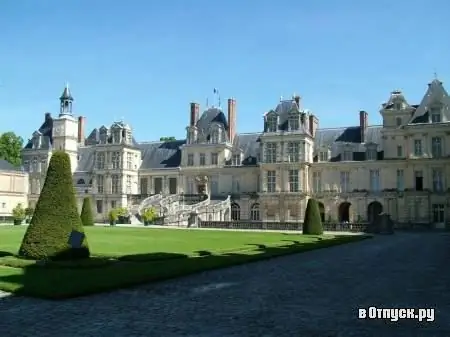
Description of the attraction
Fontainebleau Castle is a royal palace sixty kilometers from Paris. Versailles, of course, is better known. But Fontainebleau is not inferior to him in the richness of historical events, in beauty and wealth. And there are ten times fewer visitors here than in Versailles - no crowds, you can safely walk in the park.
The castle was first mentioned during the reign of Louis VII (1137). It was here on Christmas Day 1191 that Philip Augustus, the first monarch no longer of the Franks, but of France, celebrated his return from the Third Crusade. The fortress was rebuilt by Saint Louis, in 1268 Philip the Handsome was born in the castle - he also died here, having fallen from a horse. Part of the history of Fontainebleau was written by royal ladies: the future Queen of France Jeanne of Burgundy and Queen of England Isabella of France lived here, the future King John II the Good and the Duchess of Bona of Luxembourg, who died without waiting for the crown, signed a marriage contract.
The heyday of the castle fell on the 16th century, the era of Francis I, - he rebuilt Fontainebleau in the spirit of the Renaissance. The medieval fortress was demolished (with the exception of part of the curtains) and a huge palace with extended wings was erected. The work was carried out by outstanding Italian masters - the architect Sebastiano Serlio, the painter Rosso Fiorentino. For Fontainebleau, the king bought "Mona Lisa" by Leonardo da Vinci, paintings by Raphael, copies of Roman statues, magnificent bronze.
Fontainebleau fell in love with Henry II, who succeeded Francis - most of his children were born here. However, Henry's descendants preferred the Louvre and Blois as their residences. Nevertheless, at the turn of the 16th-17th centuries, outstanding French and Flemish masters - Martin Freminet and Ambroise Dubois - were invited to reconstruct the palace. The "second school of Fontainebleau" was born, which became a phenomenon of French art.
European monarchs connected their biographies with Fontainebleau: here the Polish king Vladislav IV signed a marriage contract, here the Swedish queen Christina killed her squire and lover Monaldeschi, and in 1717 Peter the Great visited the castle.
During the Revolution, the castle was damaged by robberies and fires, but in 1804 Napoleon began to revive it. Here he imprisoned Pope Pius VII, who excommunicated the emperor from the church, and in 1813 a concordat was concluded, subordinating the ecclesiastical throne to the monarch. This did not help Napoleon: a year later, it was in Fontainebleau that he signed his first abdication. On April 20, 1814, in the ceremonial courtyard, the emperor said goodbye to his old guard.
The palace in the style of French Mannerism that was born here is magnificent. A huge horseshoe staircase leads to the main entrance. The exposition numbers up to forty thousand items - from paintings by great masters to royal furniture. Here you can see the very room in which Napoleon abdicated the throne, the apartments of the Empress Josephine, the Ballroom with paintings dedicated to hunting, the Throne Room.
The main facade of the palace overlooks a huge pond with carp. Around - a park with an area of 130 hectares: Diana's garden, English … Further - the forest of Fontainebleau, which inspired the impressionists and artists of the Barbizon school.







